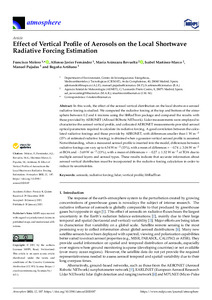Por favor, use este identificador para citar o enlazar este ítem:
http://hdl.handle.net/20.500.11765/12683
Effect of vertical profile of aerosols on the local shortwave radiative forcing estimation
Registro completo de metadatos
| Campo DC | Valor | Lengua/Idioma |
|---|---|---|
| dc.contributor.author | Molero Menéndez, Francisco | es_ES |
| dc.contributor.author | Fernández García, Alfonso Javier | es_ES |
| dc.contributor.author | Revuelta, María Aránzazu | es_ES |
| dc.contributor.author | Martínez Marco, Isabel | es_ES |
| dc.contributor.author | Pujadas, Manuel | es_ES |
| dc.contributor.author | Artíñano, Begoña | es_ES |
| dc.date.accessioned | 2021-02-02T12:48:03Z | - |
| dc.date.available | 2021-02-02T12:48:03Z | - |
| dc.date.issued | 2021 | - |
| dc.identifier.citation | Atmosphere. 2020, 12(2), 187 | es_ES |
| dc.identifier.issn | 2073-4433 | - |
| dc.identifier.uri | http://hdl.handle.net/20.500.11765/12683 | - |
| dc.description.abstract | In this work, the effect of the aerosol vertical distribution on the local shortwave aerosol radiative forcing is studied. We computed the radiative forcing at the top and bottom of the atmosphere between 0.2 and 4 microns using the libRadTran package and compared the results with those provided by AERONET (AErosol RObotic NETwork). Lidar measurements were employed to characterize the aerosol vertical profile, and collocated AERONET measurements provided aerosol optical parameters required to calculate its radiative forcing. A good correlation between the calculated radiative forcings and those provide by AERONET, with differences smaller than 1 W m-2 (15% of estimated radiative forcing), is obtained when a gaussian vertical aerosol profile is assumed. Notwithstanding, when a measured aerosol profile is inserted into the model, differences between radiative forcings can vary up to 6.54Wm-2 (15%), with a mean of differences =-0.74±3.06W m-2 at BOA and -3.69Wm-2 (13%), with a mean of differences = -0.27±1.32Wm-2 at TOA due to multiple aerosol layers and aerosol types. These results indicate that accurate information about aerosol vertical distribution must be incorporated in the radiative forcing calculation in order to reduce its uncertainties. | es_ES |
| dc.description.sponsorship | This research was funded by European Union’s Horizon 2020 research and innovation programme through project ACTRIS-2 (grant 654109), the Spanish Ministry of Economy and Competitivity (CRISOL, CGL2017-85344-R and ACTRIS-ESPAÑA, CGL2017-90884-REDT) and Madrid Regional Government (TIGAS-CM, Y2018/EMT-5177). | es_ES |
| dc.language.iso | eng | es_ES |
| dc.publisher | Multidisciplinary Digital Publishing Institute | es_ES |
| dc.rights | Licencia CC: Reconocimiento CC BY | es_ES |
| dc.subject | Aerosol | es_ES |
| dc.subject | Radiative forcing | es_ES |
| dc.subject | Lidar | es_ES |
| dc.subject | Vertical profile | es_ES |
| dc.subject | LibRadTran | es_ES |
| dc.title | Effect of vertical profile of aerosols on the local shortwave radiative forcing estimation | es_ES |
| dc.type | info:eu-repo/semantics/article | es_ES |
| dc.relation.publisherversion | https://dx.doi.org/10.3390/atmos12020187 | es_ES |
| dc.rights.accessRights | info:eu-repo/semantics/openAccess | es_ES |
| dc.relation.projectID | info:eu-repo/grantAgreement/EC/H2020/654109 | es_ES |
| Colecciones: | Artículos científicos 2019-2022 | |
Ficheros en este ítem:
| Fichero | Descripción | Tamaño | Formato | ||
|---|---|---|---|---|---|
| atmosphere-12-00187-v... | 5,3 MB | Adobe PDF |  Visualizar/Abrir |
Los ítems de Arcimis están protegidos por una Licencia Creative Commons, salvo que se indique lo contrario.





